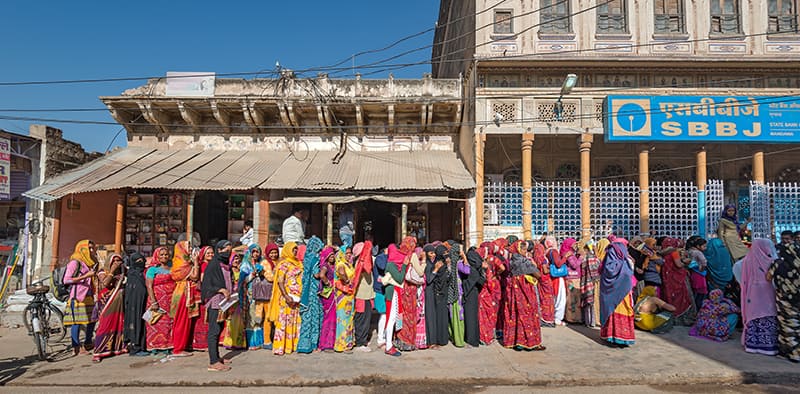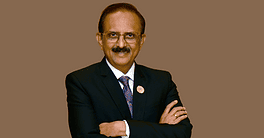India’s banking system, weighted toward state-backed entities, is opening up to private-sector banks to boost competition.

The banking system in India is at a crossroads.
The government is rushing pell-mell into the digital era, pushing high-tech biometric identification cards and a cashless society, while the country enjoys fairly reasonable growth of 5.7%. Those factors are attracting private-sector banks and fintechs eager to cash in on a population of over one billion that is increasingly equipped with smartphones and Internet access.
Yet the banking system is still dominated by state-run banks that currently suffer from weak balance sheets, struggling under the weight of nonperforming loans. How can India’s banking system be strengthened to meet the needs of the world’s second most-populous nation?

“There are two factors we need to think about,” says Viral V. Acharya, deputy governor of the Reserve Bank of India (RBI), India’s central bank. “First, we need to ensure financial stability, and to do that it is paramount to recapitalize. Second, there should be a fundamental rethink of ownership structures and the way the banking system is organized right now.”
Public sector vs private sector
India has 21 listed state-run banks that serve the bulk of the market, accounting for 74% of all bank deposits, which totaled $1.7 trillion as of August 18. Total bank credit stood at $1.2 trillion. The State Bank of India (SBI), with a market cap of about $37.3 billion, is the largest. Still, there aren’t big market-dominating banks, as in some Western countries: There is no Indian equivalent to JPMorgan Chase in the United States, for example, or Deutsche Bank in Germany.
Vying for customers alongside the public-sector banks (PSBs) is a similar, but slowly growing, number of licensed private-sector banks. There are also 42 foreign private banks, such as Standard Chartered, which has been in India for over 100 years. But so far, foreign banks’ imprint on Indian banking has been relatively small, due variously to smaller local footprints than local competitors, higher costs of expansion and stricter regulatory regimes, including recent capital requirements.
Still, private-sector banks generally have seen steady growth and success in the Indian market of late; their share of market cap increased from 40% to 70% between 2006 and 2016, according to McKinsey. A report from brokerage firm Motilal Oswal looks at growth in private-sector banks, finding that when it comes to savings account market share, the biggest gainers since 2003 have been HDFC Bank (5.7%), ICICI Bank (5.1%) and Axis Bank (3.7%).
“Private banks have done reasonably well in the banking space and as nonbank financial institutions,” according to Acharya. “We need to take cues from that and realize that banking and nonbanking finance entities can flourish even if they don’t have the backing of the state.”
This represents a radical rethinking of the Indian banking system. Acharya floats some possible approaches: “The first step could be government divesting in public-sector banks, up to 52% stakes. Next, reprivatizing some of the smaller entities that are not doing too well, to see if these can be turned around as test cases to learn from and do more further down the road.”
The weight of bad assets
Not too long ago, India enjoyed meteoric growth rates—second only to China’s. In those flush times, companies borrowed at record levels, expanding rapidly. It all came to a screeching halt in 2008. Sectors like steel, power and infrastructure defaulted on loan payments; and India’s banks piled up bad assets and nonperforming loans. Combined, the total amount of NPLs is in the area of $129.6 billion, according to India-based credit evaluator CARE Ratings. While all banks suffered, the public-sector banks ended up significantly more exposed than their private-sector rivals.
The government is trying to clean up problem loans. “In the last six months, we have taken major strides,” Acharya says. “About 25% of nonperforming assets have been filed under bankruptcy courts. We are trying to continue moving forward on the back of the bankruptcy system.”
Acharya expects the clean-up effort to take a year or two, and it’s still only half the equation if the desired result is a healthy economy. “[Bankruptcy] is on the resolution side,” he says. “Along the way, we also need to address public-sector bank recapitalization, because resolution will involve haircuts on bank balance sheets. And banks need to be able to bear these losses and at the same time intermediate demand to growing sectors of the economy.”
The state would prefer to minimize the need for haircuts. Finance minister Arun Jaitley said at a recent insolvency summit that “the ultimate objective, really, is not liquidation of assets (but) saving these businesses,” either with the existing owners or by bringing in new partners, according to the Hindustan Times, to “make sure that these valuable assets are preserved.”
Mismatched valuations
That raises the question of asset valuations. “There is a lot of mismatch in terms of what the assets are being valued on bank balance sheets and their actual value [in the market],” says Sri Karthik Velamakanni, lead banks analyst at Investec. “About 10% of banking system assets are declared as stressed. That 10% is valued [by the bank] at 70 cents to the dollar, but the market values these assets at 30 cents to the dollar. So there is no price discovery at this stage, and private capital is not coming through.”

Others see the prospect of buying out a large chunk of these assets at a nominal value as attractive. “Of late, we have seen an increased interest by global investors in stressed assets in the commodity sector, like steel,” says Siddharth Purohit, a senior research analyst at Angel Broking in Mumbai.
The timing may be just right. “Given the pace at which the stress is being recognized, things should start to improve. We should start seeing a difference in the next 12 months or so,” says Velamakanni. “A lot of countries go through a similar phase of balance-sheet recession. I wouldn’t call this a balance-sheet recession—the situation is not so extreme—but I would definitely say it is a balance-sheet realignment.”
Policy options for recapitalizing state-owned banks include offering shares to the public or injecting money, but so far the government has focused on consolidation. Recent deals merged six banks into the State Bank of India in a bid to create fewer, stronger banks.
“This government is trying to merge small PSBs with larger ones and consolidate,” according to Rethish Varma, lead researcher at William O’Neil, a stock brokerage in Bengaluru (Bangalore). “This is a positive move in the long run; but in the short run, it will create several bottlenecks. There is also no clear timeline on when these synergies will start yielding positive result.”
India’s financial community has a lot on its plate: structural changes, operational changes and demographic changes. And it is all playing out in the world’s sixth-largest economy.
“Whatever the structure of the banking system—state-owned versus private banks, or banks versus nonbanks—the most important thing is financial stability,” says the RBI’s Acharya. “By that, I mean not that the system never gets into stress, but that even in stress, it has adequate buffers to keep lending and helping growth.”



